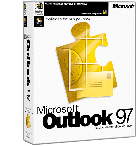Advantages of Developing Applications with Microsoft Outlook
by
Darryl B. Smith
6/27/97

Microsoft Outlook is far more than an E-mail tool. As anybody who has used it will attest to, Outlook has workgroup capabilities right out of the box. These built-in capabilities are the cornerstone for an elaborate development environment that can be used to quickly develop applications. This environment can be used by both end users and corporate IT staff to develop and distribute information sharing solutions. End users are empowered because the Outlook design environment provides a non-programming platform for creating rich workgroup enabled applications. IT Staff are empowered because the Form Designer provides a Visual Basic Script Editor window with custom controls that can be extended with Visual Basic for Applications or ActiveX Controls.
Out of the Box Capabilities
By connecting Outlook to an Exchange Server, an instant distributed groupware application environment is created. Standard capabilities, such as offline folder synchronization, allows all information to be available whether you are connected to the network or not. This is done, by storing the information from an exchange server in a secure offline file. This file is accessed while working offline and can be synchronized to the exchange server the next time you are connected. This allows a mobile workforce to continue to use their applications even while on the road. With Outlook, an application built for internal use can be migrated to a distributed application without any additional development.
Outlook Forms Designer
The Outlook Forms Designer is built directly into the product, so opening the Forms Designer is as easy as opening a form in Outlook and clicking Design Outlook Form on the Tools menu. Outlook Forms are fully 32-Bit Forms, so they are fast, and perhaps equally important, they're small, averaging about 10K. Outlook Forms are not compiled, they are interpreted at runtime. This means they're easy to update as each time a user opens a form they get the latest version. Outlook's uses a simple, standard file format that allows developers or end-users to make changes to forms and then publish them to the library as easily as they would save a file. Outlook Forms provides built-in functionality for starting new applications. When building an application, developers or end-users can start with any of the built-in modules, one of the standard message, post, or any Microsoft office form or template. Because most of the common functionality is already supplied , high-quality applications can be built in days, or even hours.
Outlook is Fully Integrated with Microsoft Office
When creating groupware, developers or end users can start with the Microsoft Office. Using ActiveX™ Technology, Outlook form-design tools can transform existing Microsoft Office documents into customized groupware and workflow forms. Thus, organizations can make use of their investment in Microsoft Office to provide simple yet highly effective groupware applications. With forms based on Microsoft Office documents, users get the best of Office technology, Microsoft Exchange (security and connectivity) and standard Outlook features such as delivery, return receipts and Inbox management rules.
Outlook is Internet Enabled
Outlook enables administrators and users to create custom groupware and workflow applications based on customized forms. Typically, custom forms are stored in a Microsoft Exchange Server forms registry. However, Outlook Forms can also be included as part of an e-mail message that is sent across the Internet. Sending custom forms over the Internet extends the power of groupware applications beyond the user's immediate group or organization, employing the Internet's connectivity to create specialized, even individualized, groupware applications. By clicking the "Save Form Definition with item" checkbox on the properties page in the forms designer, the form is automatically sent along with the message. Anybody with Outlook who receives the message, has the form displayed. They can then fill it out and e-mail it back. Remember, when using this capability, the form will always remain with the data. This would not be a good option when developing forms internally, as new versions of the form will not be automatically be propagated.
Outlook is Extensible
The groupware applications that can be created with Outlook can be made richer still through the use of the Microsoft Visual Basic® programming system, the Visual Basic Scripting Edition (VB Script) and ActiveX™ Controls. VB Script is a powerful scripting language that has been integrated into the Outlook form-design environment. ActiveX™ Controls are Internet- and Intranet-ready controls that can be dragged and dropped onto both HTML pages and Outlook Forms to extend the functionality of Intranet and groupware applications. Together, these technologies give Outlook an unparalleled set of custom application design tools.
Summary
Outlook is an extremely powerful groupware and messaging system. It works well as an e-mail tool with features such as an rtf or MS word e-mail editor. It also comes with a very effective calendar/group scheduling system, contact manager, to-do list and an interesting journal feature. It excels, however as a groupware tool. With a development environment that satisfies both the developer and end-user. For the Developer, capabilities such as Visual Basic®, VBScript and ActiveX™ Controls, as well as a fully 32-bit environment allow for feature rich applications to be built using popular languages. For the End-user, full integration with Microsoft Office and a easy to use Forms designer allow workgroup applications to be built by the novice. Both groups also get an internet-enabled instant groupware environment for distributed or collaborative information sharing applications.